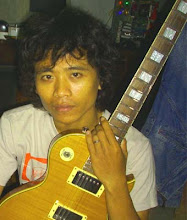Andra And The Backbone Guitar Solo
Biografi
Andra Junaidi dilahirkan pada tanggal 17 Juni 1972 sebagai anak bungsu dari enam bersaudara hasil pernikahan pasangan A. Ramadhan dan S.M. Fadilah. Andra mengaku terlambat mengenal musik, karena baru SMP lewat ekskul musiklah ia mulai tertarik pada musik. Pertama ia bermimpi untuk menjadi seorang drummer terkenal, tapi karena masalah biaya untuk membeli Drum sangat mahal dan setelah melihat teman2nya asyik memetik gitar, hobinya pun berganti. Bermodal gitar pinjaman, ia mulai belajar gitar, dan memang karena bakat, kemampuan dan teknik permainannya berkembang sangat pesat. Di SMPN 6 inilah, Andra bertemu dengan Dhani, Wawan, dan Erwin kemudian mereka sepakat untuk membentuk band dengan nama Dewa. Aliran rock yang pertama mereka geluti akhirnya pindah ke jazz akibat pengaruh Erwin. Masalah kemudian bergelayut pada kehidupan Andra yaitu ketika ia harus memilih antara kariernya sebagai pemusik atau meneruskan kuliahnya di jurusan ?desain interior. Dengan pertimbangan yang matang, akhirnya Andra memilih untuk terus meniti karier di dunia musik, tapi bukan berarti langkahnya tetap ?mulus, karena kedua orang tuanya tidak setuju kalau Andra harus melepaskan bangku kuliahnya. Layaknya orang tua biasa, mereka ingin melihat Andra meraih gelar sarjana seperti kelima kakaknya yang sudah selesai. Tapi akhirnya kedua orang tuanya mau mengerti dan memang terbukti pilihan Andra tepat. Setelah melepaskan kuliahnya, konsentrasinya ke Dewa 19 membuat kreativi- ?tasnya lebih tergali. Kontribusi Andra terhadap komposisi lagu Dewa 19 tak bisa dipungkiri.
Pada tahun 1999 Andra menikah dengan Ismulia Permatasari dan sudah dikaruniai seorang putri yaitu Yasmeen Fadilah dan seorang putra yang diberi nama Timur Zavier.
Andra yang merupakan salah satu motor dan pendiri grup Band Dewa19, dengan kesetiaan seorang Andra dalam membesarkan Dewa19 itulah yang patut diacungi jempol, karena Andra adalah satu2nya orang selain Dhani sendiri yang dari awal sampai sekarang masih merupakan personil Dewa19. Tapi dari dulu Andra memang sangat ingin membuat album solo sendiri, sedikit demi sedikit dia mengumpulkan lagu2 yang diciptakannya sendiri untuk project album solonya. Tapi karena jadwal Dewa19 yang sangat padat dan memang orientasi pertama adalah untuk band kesayangannya itu maka Album solonya sedikit tertunda.
Sampai pada tahun 2006 saat jadwal Dewa19 tidak terlalu padat akhirnya Andra mulai serius membuat Album solonya itu. Karena ditahun-tahun sebelumnya Andra bertemu dengan Stevie Morley Item yang kala itu sebagai additional player Dewa19 dan merasa cocok dengan gaya permainan Stevie, jauh2 hari Andra sudah pernah menawarkan kepada Stevie untuk ikut bergabung dalam project tersebut. Mereka berdua seperti mempunyai misi dan visi yang sama dalam hal bermusik.
Ditahun yang sama Andra & Stevie menemukan seorang Dedy Lisan yang menurut mereka cukup cocok membawakan lagu2 ciptaan Andra. Setelah mereka membuat demo dan menyerahkan ke label rekaman, dengan jalan yang bisa dibilang cukup mulus akhirnya mereka berhasil menelorkan album pertama mereka Andra and The BackBone dan mengusung nama yang sama untuk nama band mereka. Akhirnya berhasil juga perjuangan seorang Andra mempunyai Album yang sudah lama di nanti2kan oleh banyak penggermarnya. Dengan keluarnya Album tersebut bukan berarti Andra tidak setia lagi dengan band terdahulunya Dewa19, justru hal ini yang tetap mempererat hubungannya dengan Dhani dan Dewa19 itu sendiri. Selain dapat restu dan persetujuan dari Dhani juga karena Dewa19 tetap merupakan prioritas utama Andra dan Backbone sebagai selingan dan mainan barunya.
Lahir 17 Juni 1972 (umur 38)
Bendera Indonesia Indonesia
Pekerjaan musisi
Tahun aktif 1992 - sekarang
Mempengaruhi Dewa 19, Andra and The BackBone
Anak Yasmeen Fadilah
Orang tua A. Ramadhan dan S.M. Fadilah
Nah... Hebat kan Andra??? menurut saya sih Hebat,,, gak percaya kita buktikan.
beriku saya kasih Tab lagu dari solo gitar nya Andra, dari album ke 2 nya Andra&thebackbone yaitu 3 keajaiban
3 keajaiban guitar pro tab
tab diatas bisa dijalankan dengan GUITAR PRO 6.0 bisa di download di sini
Ok Enjoy!!!Just play your guitar now...
Label: Guitar Software

























